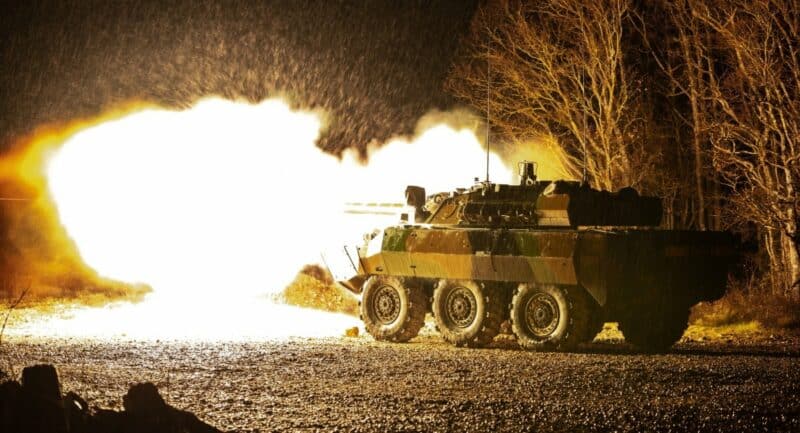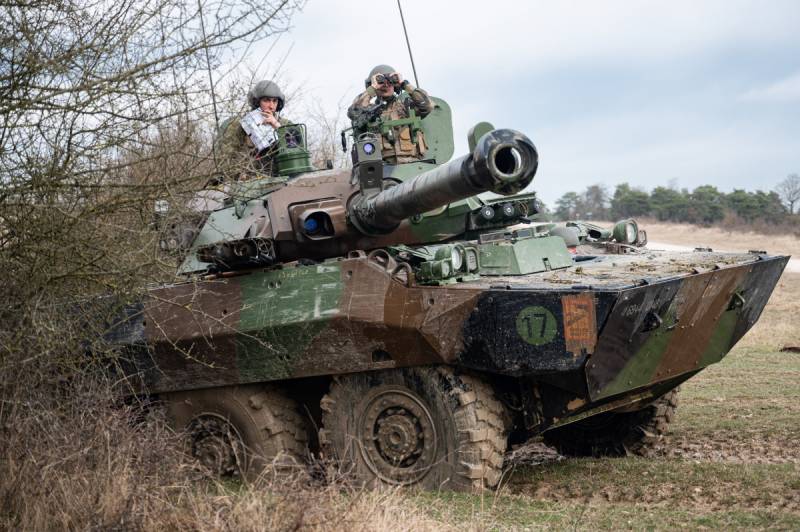In January 2023, France was the first Western country to announce the sending of combat tanks, as designated then, to Ukraine. They were, in fact, AMX-10RC armored reconnaissance vehicles, a 6×6 armored vehicle armed with a 105 mm cannon, but far too light, and insufficiently protected, to be qualified as combat tanks.
However, the French initiative served as a trigger, followed shortly after by Great Britain, which announced the sending of around ten Challenger 2s, for once, a real heavy tank, perhaps even too much, for the Ukrainian theater. After which, Americans and Germans softened their positions, allowing the sending of M1A1 Abrams and especially Leopard 1 and 2, adapted to Ukrainian needs.
Since then, the AMX-10RC like the Leopard and Abrams, experienced the test of fire. If the German and American heavy tanks have shown, without being invulnerable, qualities in line with expectations, the French light armor leaves a more than mixed feeling among its Ukrainian users.
While the first Jaguar EBRCs entered service within French cavalry units, to replace the AMX-10RC in their missions, the Ukrainian experience provides a vision that is mixed to say the least, as to the effectiveness, and even the usefulness, regarding this armored guy, at least as far as this conflict is concerned.
In this section:
The AMX-10RC, an armored reconnaissance vehicle poorly understood and misused by the Ukrainians?
It is true that initially, the Ukrainian units equipped with French AMX-10RCs attempted touse the armored vehicle like a battle tank, which it is not. The results were, as might be expected, quite catastrophic.

Indeed, the armor of the light tank (or little gives its name), barely allows it to resist fire from light weapons and heavy machine guns. Thus, the smallest 25 or 30 mm cannon is enough to pierce the AMX-10RC, including in the frontal sector, this effectively disqualifying it from the battle tank function.
In addition, its 105 mm pressure trap cannon F2 BK MECA L/48 gun, has performances much lower than those of the 120 mm cannons of Western tanks, and even that of the L7A43 cannon of the Leopard 1. In other words, the AMX-10RC has neither the protection nor the firepower sufficient to use it as a battle tank, even a medium one. It is therefore not surprising that the armor suffered significant losses, when used as such, by the Ukrainian forces.
In French doctrine, the AMX-10RC must be used for armed reconnaissance, serving to accompany the opposing force under fire from Allied defensive lines, or to carry out support missions for the benefit of the infantry.
Once the thing was assimilated by the Ukrainian military, we could then expect much better behavior regarding the French armored vehicles in this engagement. However, it is anything but obvious...
The armed reconnaissance function facing drones and positional warfare: does the AMX-10RC have its place in the Ukrainian conflict?
And for good reason: the dynamics of the Ukrainian conflict are very different from those imagined by the French military when they designed the AMX-10RC. First, reconnaissance, the primary function of armored vehicles, is entirely delegated to drones in this conflict.


75% of this article remains to read,
Subscribe to access it!
The Classic subscriptions provide access to
articles in their full version, and without advertising,
from 6,90 €.
Newsletter subscription
Register for the Meta-Defense Newsletter to receive the
latest fashion articles daily or weekly


Whatever one thinks of armored vehicles like the Jaguar/10RC, the proportion they occupy in the French armies compared to battle tanks (4 brigades equipped with Jaguar and 2 with Leclerc) seems to me totally unsuitable for our needs. I mean, the reconnaissance elements have always been supposed to be less numerous than the battle corps, but here we have 4 light brigades, of which the GTIA would therefore be incapable of leading assaults, for 2 heavy ones, it doesn't matter. What.
Exact !
I like our military, but we still have a real problem in the contact zone to deal with flying scrap metal.
A comparison of the armor announced according to stanag 4569 shows:
Ballistic protection level 4 for the VBCI (resists 7,62mm), level 5 (resists 12,7mm machine gun) for the Jaguar or CV90, level 6 for the Lynx (resists 14,5mm).
If we add that wheeled vehicles can hardly reconcile the addition of additional armor plates and mobility on wheels, there are still some questions to ask about our choices and where our army will have to go. I am not at all confident about the chances of survival of our crews in our vehicles in the Ukrainian theater.
What’s the plan… Shall we do one again? Should we give up sending contact vehicles to Ukraine? Option 2 seems the most logical to me. And I don't understand the idea of buying more VBCIs to replace Jaguars. It's by far the least well protected, so what's the idea? Abandon the idea of fire support through direct fire and have a minimum of armor for infantry transport, while abandoning the very idea of armed reconnaissance?
The whole question is whether armed reconnaissance still makes sense, in a world saturated with drones? Also, VBCI 2 is Stanag 5, so same as Jaguar. (https://www.forcesoperations.com/amp/nexter-promeut-son-vbci-2-en-lituanie/)
Finally, in terms of tense fire, a VBCI 2 has the same firepower as the Jaguar, but can rely on a dismounted combat group.
Comparing the Lynx at €20 million each, and the VBCI 2,5 times cheaper, is of little interest.
In relation to Ukraine, it would be relevant to study the causes of destruction of Western IFVs since they were sent. I have the impression, with a wet finger, that it is primarily due to missiles, rockets and lurking munitions, and very little to tense fire. In this case, it is mainly the addition of Diamond, and not armor plates, which could make the difference. But, once again, this deserves methodical analysis.
Hello,
Is the VBCI 2 equipped with anti-tank missiles like the Jaguar? I don't think so, and it's still an important difference in the context of protection. Afterwards, I am not an expert but I suppose that Akeron or another anti-tank missile must be able to be integrated into this vehicle. In case it is feasible, you are right, a VBCI2 is more interesting than a Jaguar. But this detail of anti-tank missiles is still important, I think.
The philoctete is. And the model presented by Nexter to Idex was too. Afterwards, I am not in the secret of the gods on this subject ))
Thank you for your response, however there are a few questions: If brazen combat vehicles are not destroyed by 25mm cannons, why? They're not powerful enough, don't shoot far enough? The other underlying question is why do we want a 40mm gun? If our IFVs are not destroyed by small caliber rapid-fire cannons, why would we want larger ones, what is the use of them? The fight against drones seems to be satisfied with small calibers.
This is certainly worth studying. The T40 turret has the advantage of being available, but perhaps it is not the most suitable.
I looked at stanag 4569, going to the source of the standard, the problem is a little more complicated than what I understood at first glance. Resistance to tense shots is understood as the ability to stop a projectile with a defined hardness at a given distance. The projectile may be a small caliber shell or munition or large caliber shrapnel. In the case of a large caliber shell, we will judge the splinter stopping capacity when the shell itself falls x meters from the tank. The test must be repeated several times. The position of the crew in the vehicle is therefore also important in judging the armor. In short, a more in-depth analysis would be necessary to talk about it correctly and intelligently discuss how to pierce armor.
in fact if the rapidfire combined with the paseo (native on jaguar) + the sound detector (the small mast with three domes which I have
We need a radar, electro-optics are not enough. What's more, from memory, the elevation of the CT40 is 45° max. It is not an anti-aircraft weapon, at least on the EBRC. As for the RapidFire turret, it was simply designed to go on a ship, which already has radar, and does not have the same constraints of weight, mobility, etc. Starting from the CT40 to make a SHORAD armored turret, Yes. But not Rapid Fire. Not to mention the fact that it is also essential to add MANPADS or lighter missiles.
I forgot the name) make it a fantastic hunter of anything that flies within a 4 km radius